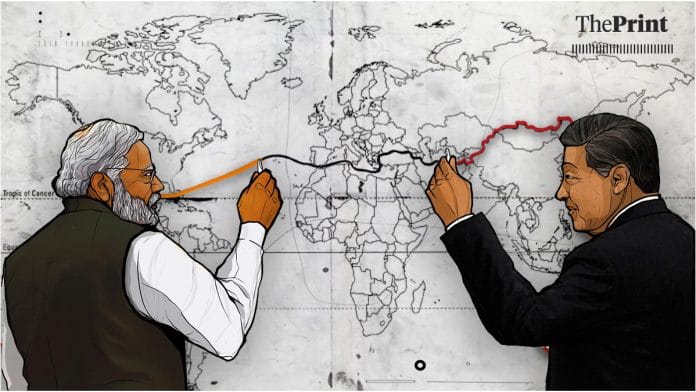Thousands of metres above the Himalayas, India and China are contesting over metaphysical territory. Similar to the territorial battle, this ideological battle exhibits the two countries’ ambitions to prove their intellectual capabilities to lead the ‘Global South’. And the battle is not new. Its genesis lay in the 1950s when both New Delhi and Beijing competed for leadership of what was referred to as the Third World. That culminated in the 1962 war, which was not only a result of a land dispute but also a tussle over ideas and leadership of the Third World countries. When an ideological battle blends with territorial conflict, then artificial tectonic shift burgeons the height of the Himalayas, both underneath and up.
The Global South has once again become a metaphysical battleground for India and China. Once the nomenclature of Third World countries was picked up by India to redefine the new identity of the Global South and assert rights over requests in international politics, China suddenly felt its leadership was being challenged by India. Nonetheless, Beijing hesitated to accept the new reality of Global South identity and insisted on continuing with the term ‘developing countries’ to identify the states of Asia, Africa, and Latin America.
At first, Chinese scholars showed a calculated attempt to negate and downplay the use of ‘Global South’. But when it became unavoidable to ignore the emerging ontology of identity, they started discrediting India’s leadership role, questioning its capability to fulfil the aspirations of the Global South countries.
Chinese scholars picked it up from the American playbook—deny China’s rise rather than attribute it to Beijing’s call for a ‘new type of great power relation’. American policymakers and most scholars weren’t acknowledging the proverbial Thucydides trap to legitimise China as an emerging hegemon.
Also read: Modi has exhumed Nehru’s Global South. Which fails the test of geography, geopolitics and economics
Coming to terms with it
India’s rise to the global stage is altering China’s geometrical formula of engaging with Delhi. Beijing’s hesitancy toward India evaporated with the realisation that it could no longer afford to let Delhi be the sole leadership claimant, as the Global South concept quickly gained currency in academic and policy debates around the world. Most importantly, countries of the Global South also began to identify with the new concept.
Once the inertia ceded, Beijing proposed a barrage of new theoretical approaches and old gimmicks to align the Global South with Chinese leadership.
First, the Global South was equated with Chinese discourse to end the America-led Western hegemony. Second, all other Chinese initiatives, such as the Belt and Road Initiative (BRI), Global Development Initiative (GDI), Global China Initiative (GCI), and Global Security Initiative (GSI) rallied behind the Global South to dismantle this domination and usher the new world order with Chinese characteristics. Third, even minilaterals, ironically not Chinese-led, like BRICS and G20, were seen as instrumental in consolidating Chinese leadership positions in the Global South.
Chinese epistemology on the Global South differs radically from Indian verbal expressions. Delhi infuses normative values of coexistence with the “other world”. The philosophical foundation of Indian traditions respects the metaverse reality and sees it as a bridge in the contemporary world. Indian traditions prosper in the diversity of ideas. Chinese traditions, although they have evolved, have taken learnings from different knowledge systems only to assimilate them in the broader ambit of ‘Chineseness’.
Also read: SCO, BRICS, RIC: What do they have in common? China at head of table, India faking smiles
Adopt a metaverse approach
Indian ways are irreconcilable to the Chinese mind, and the Chinese path is an unfamiliar terrain to the Indian soul. But finding compatibility is not insurmountable. The Himalayan heights are no longer a physical barrier but a state of the mind.
Both countries do show epistemic convergences on the broader contours of the Global South to let countries “advance their own economic and social progress, promoting diversity and inclusivity in political institutions, and upholding their own cultures and values.”
The ontological contestation over the Global South limits the cognitive approach in constructing and engaging in a meaningful dialogue. The absence of dialogue exacerbates epistemological territorial disputes. But unlike material disputes, the evasive nature of metaphysical dissension makes it impossible to respond and remit. Given that Indian and Chinese minds are wired differently, interactions and connections of centuries have helped little to change that. This necessitates both countries to adopt a metaverse approach to genuinely comprehend each other’s thought processes. Simplifying the complex narrative into the binary of variables — democratic and communist — renders little imputes in deciphering Mandarin and Sanskrit. Here, Mandarin and Sanskrit are symbolic and should not be deduced to ekam satya.
But inferences derived need to be grounded in reality, which is relative in a sense. To make sense of it, both India and China must augment the capability to acquire and create knowledge. Knowledge cannot be selectively generated and applied to maximise short-term interests, which are fluid and change with time.
The multiverse knowledge of both Jambudwip and Huaxia, thereby, is a prerequisite in navigating through Bharat and Zhongguo. Knowledge creation should be the sole objective to realise the One World, One Future goal. Knowledge sharing is a must, therefore, to avoid the three-body problem of our metaverse reality.
The author is Associate Professor of Chinese Studies, Department of East Asian Studies, Delhi University. He tweets @mrajivranjan. Views are personal.
(Edited by Humra Laeeq)






